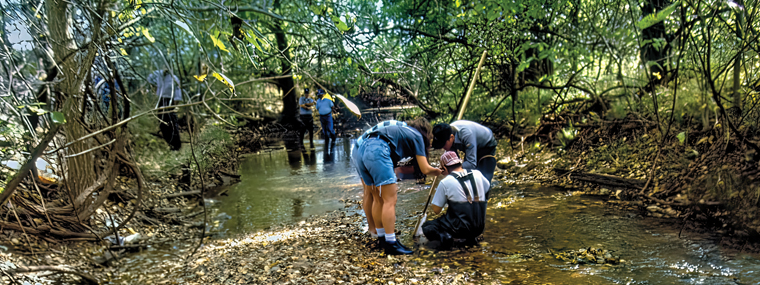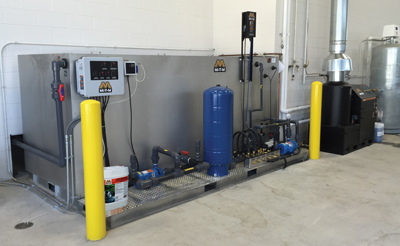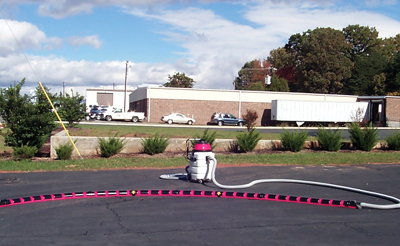
Power Washers’ Guidebook
Environmental Concerns, Part II
Main Contributor: Jimmy Welch, Vice President of Engineering, American Pressure Inc.
Additional support: Ron W. Robarge, P.E., Director of Engineering, Spartan Manufacturing Corporation; and Aaron Auger, Water Treatment Division Manager, Mi-T-M Corporation / Published December 2022

Author’s Note: There are several links to online resources to further support the information presented in this article. They are referenced in a bibliography at the end of the piece. While full links are provided, you may find it easier to simply type the descriptions in a Google search. A sidebar with acronyms is also provided for your convenience as acronyms are used throughout the article.
Editor’s Note: Part I can be found in the November 2022 issue or online at www.cleanertimes.com.
Wastewater Disposal
Disposal of industrial process waste, including wash water generated by the power washing process, is controlled differently in each location and must be disposed of according to regulations. In general, options are as follows:
- discharge to a sanitary sewer or designated (approved) area
- reclamation and recycling or
- reclamation and removal/hauling (including to an environmental waste company or transfer to a professional waste hauler).
With the exception of building washing without chemicals, most wastewater disposal will require a permit to avoid costly fines.9 The permitting system incorporates testing and documentation of results of tests on water. This is a long, costly, and site-specific arrangement. (The NPDES system actually eases the burden on individual businesses.)
As previously stated, each contractor must follow the permitting requirements for the AHJ where the job site is located. For instance, a separate permit may be required for hauling, depending on if the waste is classified as hazardous, which brings new requirements from the Department of Transportation (DOT).
Pre-cleaning of wastewater before disposal or reuse will likely be required in some instances. If it is going into a septic system, attention must be given to the chemicals and metals that could prove lethal, cause damage to the system, or pollute the leach field. If the discharge is entering a city or publicly owned treatment works (POTW) system, limits on fats, oils, and greases; total suspended solids; biological and chemical oxygen demand; and heavy metals and poisons may be imposed. (See sidebar on page 36 for an introduction to basic terminology linked to such permitting.)
Ron W. Robarge, P.E., director of engineering at Spartan Manufacturing Corporation, explains that since 1976 Spartan’s main business has been the manufacturing of a wide range of heavy-duty, industrial-grade pressure washers. By the late 1980s they recognized that environmental concerns were impacting our industry in a big way. They began to research and develop wastewater capture systems.
“The Vacu-BoomTM system was introduced to the industry in 1993 as a practical and efficient portable wastewater containment and extraction system for washing operations to comply with EPA requirements,” explains Robarge. “It is now used worldwide to prevent wastewater discharge into surface waters via sewer systems or runoff in proximity to water bodies. Vacu-BoomTM was originally held as a U.S. patent. Since the patent expired several years ago, the design has been widely copied. Similar products are now produced by several competitors; however, Vacu-BoomTM still has a loyal following for their system.
“As referenced in Part I in the November 2022 Cleaner Times, EPA laws and regulations concerning wash water capture are federally mandated,” adds Robarge, “but they are delegated for enforcement to officials from cities, counties, and municipalities throughout the USA. There are some minor variances and interpretation of the regulations
from one jurisdiction to another and differences in the degree of enforcement aggressiveness. However, the Vacu-BoomTM systems have experienced a 100 percent rate of acceptance by local regulatory authorities everywhere since their introduction, and their use is considered the standard of best practice worldwide.
We know that many thousands of Vacu-BoomTM systems are in use throughout the USA, Canada, Europe, Australia, New Zealand, and other developed nations by contractors, major corporations, military services, and environmental regulators. But our reach is larger than that as we do not know exactly where Vacu-BoomTM is used since many of the systems are sold through our global distribution network.”
Wastewater recycling is fast becoming the expectation in many regions. The investment in equipment for capture and recycling is not insignificant, but if all contractors must have the equipment, the playing field levels. And the industry is working hard to keep up the pace.10
“We are also continuously working to improve the performance of our equipment to make it easier to use, with developments in automation technology,” reports Aaron Auger, water treatment division manager at Mi-T-M Corporation. “Our water treatment system features such as auto backwash (to reverse the flow of media in filters) and automated pinch valves (to purge solids from tanks) use automation to reduce the frequent upkeep that’s otherwise done by the user.”
Emissions Controls and “Sore”
Small off-road engines (SORE) emissions are at the forefront of manufacturing technology research and development in the power washing and other industry sectors. SORE can be defined as any spark-ignited, petroleum-powered engines rated at or below 19 kilowatts. Small engines in this category include generators, pressure washers, and lawn and garden equipment as well as other outdoor power equipment, specialty vehicles, and more.11
In a June 2022 presentation, CETA addressed why emission regulations are moving to “zero” for equipment used by power/pressure washers and how the U.S. government is leaning towards electrification over gas-powered engines.
New emission requirements are to be in place in California for pressure washers beginning with model year 2024, and engine manufacturers have to work hard to evaluate the best cost-effective technology to meet these more stringent requirements. Regulations demand carbon monoxide emissions be reduced from a level of 549 in 2008 to 20.6 (or less) by 2024, and hydrocarbon plus oxides of nitrogen from 8.0 to 0.80 (or less) during the same timeframe. Certification to meet these requirements is a lengthy (and costly) process. By 2028, the current goal is zero-emission equipment (ZEE) for pressure washers sold in California.
And it is not all just about exhaust fumes. The California Air Resources Board (CARB) recognizes that, even when not in operation—i.e., they are turned off, especially after a period of use when the engine is hot—“hot soak emissions vapors” are emitted from different sources such as fuel delivery lines, purge lines to the canister, and the gas cap. These rules already apply to company vehicles, and the goal is to apply them to everything else that uses an internal combustion engine in the future.
CARB guidelines require that all engines, and equipment with engines, sold in the state of California be labeled to meet their requirements. As a result, some equipment today is labeled “Not for sale in California.” When purchasing new equipment, power washers are well advised to know SORE regulations may soon be adopted in other jurisdictions and to speak with their manufacturer and or distributors about this pending change. And, of course, representatives from CETA will continue to champion the rights and responsibilities of the power washing industry.
To add to the challenge, it is imperative that manufacturers now keep records of how they sold the equipment so that if end users modify it, the manufacturer won’t be penalized. In addition, distributors and operators should never make modifications to the emission or evaporating portion of any engine-powered equipment.
SORE affects everyone—manufacturers and distributors, contract cleaners, and rental businesses. While California may be leading the charge for change, other states have similar regulations presented (and in review) at the state legislation level. Power washing industry professionals can work at the local level to prevent regulations, keeping in mind that it all starts at “grassroots” levels, from homeowner associations to city and state levels.
The EPA Today and Future Forecasts
In 2022 climate change and global warming were front and center in both national and international news. The big question was and continues to be, are we doing enough?
On June 30, 2022, in a landmark 6–3 decision, the U.S. Supreme Court’s conservative bloc limited the ability of the EPA to address climate change, experts said, but the decision could have wider implications.
“This decision strips federal EPA scientists of their ability to help the American public tackle the worst effects of climate change and the EPA of its power to protect the environment and our communities from a worsening climate crisis,” said Marie Owens Powell, president of AFGE Council 238, the EPA’s largest employees’ union, as reported in
USA Today.12
Front and center of this discussion was the West Virginia v. the EPA court decision and Obama-era environmental regulations. Much of this conversation, and subsequent rulings, focused on the energy sector and an overall goal to substantially reduce emissions of greenhouse gasses in an effort to cut down U.S. contributions to global warming. (The energy sector is the second-largest contributor of such pollutants after transportation.)
Despite progress in the energy sector, scientists and environmental groups warn that the climate picture has worsened since 2015. Even with the unexpected drop in coal and rise in renewables, the United States is not on track to meet its climate goals of cutting greenhouse gas emissions in half by 2030. And, despite the fact that the power washing industry is a relatively small player in a global concern, we still play an important role. Chemical use, wastewater recovery, and small-engine emissions and evaporation systems control are specific areas that affect our operations and are where we can make a difference in the overall environmental picture.
Best Management Practices For Cosmetic Cleaning Activities
The primary purpose of all power washing activities should be for health and safety and to minimize pollution. In an effort to help businesses comply with the NPDES permits, Robert Hinderliter developed a list of BMPs for the proper disposal of wastewater generated by mobile business operations. (After a decades-long career in our industry, Hinderliter recently retired from his role as president at Rahsco Manu-facturing Co. Inc. and MultiTech Environmental Remediation Systems.)
Implementation of pollution prevention and good housekeeping measures may reduce or eliminate the need to implement other more costly or complicated procedures. The BMPs below provide a starter guide for contractors, who should always work in collaboration with colleagues, professional organizations, and local/regional regulators to develop specific BMPs for their respective businesses. Proper employee training is, of course, key to the success of implementation. BMPs should be constructed to comply with local NPDES permits for each jurisdiction you are working in.
BMPS For Power Washing
- BPM 1 — Never discharge to storm drains
- BPM 2 — Always pre-clean and prepare the site
- BMP 3 — Always filter wash water before discharging
- BMP 4 — Minimize the impact of cleaning products
- BMP 5 — Capture wash water
- BPM 6 — Know your wastewater discharge options
- BPM 7 — Be aware of drought conditions
- BPM 8 — Safeguard against liability
- BPM 9 — Recycle wastes whenever possible
- BPM 10 — Use your equipment
If you have specific questions regarding BMPs, contact your local sewer agency or your city or county’s NPDES coordinator. Visit https://www.epa.gov/npdes to learn more.
Bibliography
Learn More—Important Internet References & Links
9. Resource Conservation and Recovery Act — https://www.epa.gov/laws-regulations/summary-resource-conservation-and-recovery-act
10. Essential Tips for Wash Water Recovery — https://www.youtube.com/watch?v=Vg4HV9c558s
11. SORE—List to Determine Preempt Off-Road Applications — https://ww2.arb.ca.gov/sore-list-determine-preempt-road-applications
12. USA Today—Supreme Court handcuffed EPA on climate change — https://tinyurl.com/5n6ebunb
Environmental Acronyms You Need To Know
- AHJ — Authority Having Jurisdiction
- BMPs — Best Management Practices
- BOD — Biological Oxygen Demand
- CARB — California Air Resources Board
- COD — Chemical Oxygen Demand
- CWA — Clean Water Act
- DOT — Department of Transportation
- EPA — Environmental Protection Agency
- Floc — Flocculant mass formed by the aggregation of a number of fine suspended particles. Clumps of solids in wastewater
- FOG — Fats, Oils, Greases (Animal fats, petroleum distillates, etc.)
- MS4 — Municipal Separate Storm Sewer System
- NPDES — National Pollutant Discharge Elimination System
- pH — scale that indicates acidity or lack thereof, ranges from zero (most acidic) to fourteen (most alkaline) with seven being neutral
- POTW — Publicly Owned Treatment Works
- PPM — Parts Per Million. A measure of concentration of a substance (may be expressed by volume or weight)
- RCRA — Resource Conservation and Recovery Act
- SORE — Small Off-Road Engines
- TSS — Total Suspended Solids. Floating matter that can usually be filtered
- ZEE — Zero-Emission Equipment







